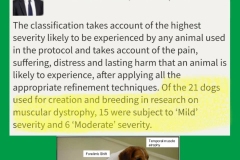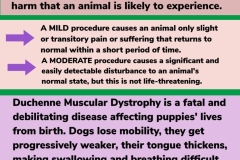The 2023 statistics of animals used in scientific procedures noted 21 dogs under the category of “Creation & Breeding of Generically Altered Animals not used in experimental procedures.”
 The Home Office confirms, via FOI, that the 21 genetically altered dogs were used on a project licence focused on breeding dogs with a debilitating disease called Duchenne Muscular Dystrophy (DMD) and then using them for tests.
The Home Office confirms, via FOI, that the 21 genetically altered dogs were used on a project licence focused on breeding dogs with a debilitating disease called Duchenne Muscular Dystrophy (DMD) and then using them for tests.
The Royal Veterinary College is a leading organisation in these cruel and flawed experiments.
Pups born with DMD are often too weak to suckle effectively, and they tend to have a high mortality rate compared to healthy puppies.
As young as 6 weeks old, muscle weakness starts to become apparent. By 10 weeks of age, the dogs’ hind legs are stiffened, and mobility is restricted. They also salivate excessively and strain to swallow because of muscle weakness in the jaw and tongue.
Despite decades of using dogs to research this disease, no cure or treatments for humans affected by muscular dystrophy have been developed.
There are cutting-edge, non-animal research methods that offer real hope to the development of a cure and treatment.
A question was asked in Parliament regarding the 21 dogs the Royal Veterinary College used for creation and breeding for muscular dystrophy research was asked .
The footage below shows the horrendous suffering and pain that dogs deliberately bred with Muscular Dystrophy endure.
These images were taken inside Texas A&M University (TAMU). After a hard-hitting campaign organised by PETA, the university stopped deliberately breeding dogs to develop muscular dystrophy (MD) – a crippling, painful, and irreversible disease.
But in the UK, the Home Office continues to give the Royal Veterinary College 5 year licences to breed beagle crosses with this disease to use them in experiments.
These ineffective experiments on dogs provide findings that can not easily be applied to humans due to physiologic differences between animals and humans.
There are non animal techniques that have a greater potential to lead to promising therapies than using animal models does.
The Camp Beagle Team


